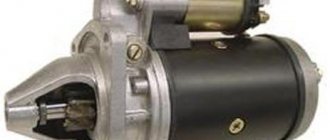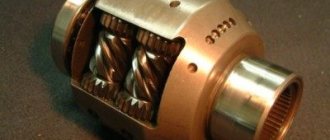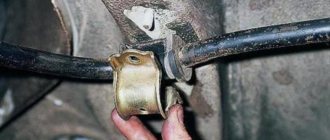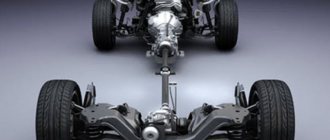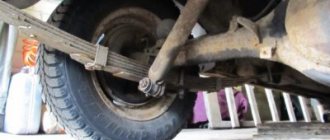Parts of the engine gas distribution mechanism experience heavy loads and high temperatures during operation. When heated, they expand unevenly, as they are made of different alloys. To ensure normal operation of the valves, the design must provide a special thermal gap between them and the camshaft cams, which closes during engine operation.
The clearance must always remain within the specified limits, so the valves require periodic adjustment, that is, selecting pushers or washers of the required size. Hydraulic compensators, sometimes called simply “hydriki” or hydraulic pushers, can eliminate the need to adjust the thermal gap and reduce noise on a cold engine.
Historical excursion
Hydraulic compensators, also known as hydraulic pushers, or in common parlance “hydriki”, appeared quite a long time ago. Let's look at why compensators are needed and how they appeared in the engines of many cars.
Drivers largely owe their appearance in the design of gas distribution mechanisms of cars to Japanese auto engineers, since it was they who began to massively use “hydraulic valves” in the design of engine timing systems. At that time, when designing an internal combustion engine, much attention was paid not only to its main components (crankshaft, pistons, connecting rods), but also to the details of the gas distribution mechanism. Engineers gradually “brought” previous generations of their power units to perfection. Thus, hydraulic pushers replaced the usual mechanical pushers.
A little history
Hydraulic compensators have replaced less efficient mechanical regulators of gas distribution mechanisms. As a rule, a regular engine valve, say on a classic VAZ 2105 - 2107 engine, does not have a hydraulic compensator, so it often had to be adjusted, on average after 10,000 kilometers. Valve adjustment on VAZ 2105 - 2107 was done manually, that is, you had to remove the valve cover and set the gaps using a special feeler gauge, which varied in thickness, which means you could choose it for your mileage.
If adjustments are not made, the car engine begins to make noise, dynamic characteristics decrease, and fuel consumption increases. I made a detailed video on why you need to adjust the valves, watch it useful.
After 40 - 50,000 kilometers, the valves generally should have been changed. That is, mechanical valve adjustment, to put it mildly, has outlived its usefulness, it was necessary to do something, to improve the design, so to speak.
So on front-wheel drive VAZ engines, they began to install mechanical pushers in front of the valve. To exaggerate, a large “cap” was simply put on top of the valve; it has a larger diameter (than the old design), and therefore wear was much reduced, because it is much more difficult to wear out a larger diameter than a small one. But adjustment still remains, of course not every 10,000 kilometers, much less often, but it is still recommended to do it. This usually happened by placing repair “washers” of increased height. Mechanical adjustments are quite effective and are still used by some manufacturers; adjustment with washers is recommended no earlier than 40 - 50,000 kilometers (if we talk about our VAZs); on some foreign cars the pushers last even longer. The big advantages are the simplicity of the design, unpretentiousness (semi-synthetic oils can be poured), as well as the relative cheapness of the design. The disadvantages can be noted that when the “washers” on top were worn out, the engine began to work noisier, the dynamic characteristics dropped and the consumption increased. What was needed was a design that automatically adjusted the gap.
And now, mechanical valve adjustment has been replaced by a completely new technology. Everything is simple here - now you don’t need to adjust the valves manually, hydraulic compensators will do everything for you. They themselves will set the required engine valve clearance, due to which the engine life is increased, power is increased, fuel consumption is reduced, and the mechanism runs for quite a long time - 120 - 150,000 kilometers (with proper maintenance). In general, a step forward.
How do hydraulic compensators work?
The hydraulic compensator device (hydraulic support) is a cylindrical metal structure. On the outside, the compensators do not have any characteristic elements (with the exception of roller-type compensators).
The entire mechanism of this part is hidden inside: there is a spring-loaded plunger and its valve (ball), a separate spring for this unit (plunger pair), and for the compensator to work, there is a special channel through which oil is supplied from the cylinder head. There is also a special compensation container in the inner part, where oil accumulates when the camshaft cam presses the compensator. This compensation capacity acts as a kind of storage device and works as a damper.
In situations where the camshaft cam does not press on the hydraulic compensator, the compensator comes into contact with the camshaft due to the work of the spring and the plunger pair. The damper is filled with oil, but this amount is not enough for the plunger pair to operate. The oil channel in the compensator is closed, and the pressure inside does not exceed such a mark that there is pressure on the timing valve.
The outer part of the compensator is in contact with the profile (cam) of the camshaft and constantly moves, thus determining the moment and time for which the valve will be open. At the moment of operation , the camshaft cam presses on the compensator body, thereby overcoming the force from the spring and the plunger pair, and opening the oil channel necessary for the operation of the plunger pair. Thus, when the camshaft cam is pressed on the compensator, oil flows into the compensator, the pressure in it increases and its operation is to open the timing valve at the right time. The plunger pair acts as a regulator and immediately after the cam passes a certain point on the shaft, it begins to “bleed” excess oil back into the system. As a result, due to the operation of the plunger pair, the pressure difference and thermal expansion of the metals, the required gap is selected and the compensator is pressed against the camshaft.
Malfunctions
Drivers of modern cars equipped with engines with hydraulic pushers often encounter problems with knocking expansion joints. Typically, such malfunctions appear at mileages of over 40,000 km or more. Why do hydraulic compensators knock? There can be many reasons for the appearance of the ill-fated clatter, let’s look at them in order.
- Using low quality oil. and/or untimely replacement of fuel and lubricants.
When cheap and low-quality oils are poured into the engine, the hydraulic compensator parts are subject to premature wear: the oil channels and the compensator valve (ball) become clogged, which is why the compensator does not close completely. In addition, with low-quality oil and improper operation of the plunger pair, oil leaks and incorrect clearance selection often occur.
- Untimely replacement of fuel and lubricants.
Rare engine oil changes are also one of the reasons for knocking compensators. Oil that has lost its working properties is prone to burning and coking, which is why deposits on the walls of the channels interfere with the normal passage and outflow of oil from the compensators.
- Insufficient oil in the system.
Car owners should not forget that it is necessary to constantly monitor the oil level in the engine using a dipstick, and it is recommended to do this every time you open the hood, since this procedure does not take more than two minutes. Therefore, when a clattering noise appears from under the valve cover, you should first check the oil level.
Different models of power units have their own typical “sores”, one of which is oil leaks. And if such design flaws in modern engine models can be found extremely rarely, then problems with consumables are much more common. The use of non-original or low-quality oil seals and gaskets can cause oil leaks and a decrease in overall oil pressure. Therefore, you should not be surprised if, when the cylinder head cover is “fogged up” or when there are leaks on the cylinder block, the compensators begin to knock. In addition to current seals and gaskets, a problem area can also be a faulty oil filter, due to which the pressure in the system drops and the oil does not flow well into the compensator wells.
- Compensator failures.
Failure of expansion joints on foreign cars is not a frequent occurrence, but when operating in the conditions of the Russian Federation and the CIS, it still happens. There are two main reasons here: - low-quality fuels and lubricants (fake or cheap oil, low-octane gasoline with harmful additives, etc.); - a cheap (unreliable) manufacturer of the compensators themselves.
The use of low-quality fuels and lubricants leads to the fact that hydraulic pusher elements simply fail over time: - the plunger pair jams; — the plunger spring fails.
- Natural wear and tear.
With a long mileage of hydraulic pushers (over 60,000 - 70,000 km), the internal parts of the compensator wear out, resulting in oil leaks from the internal cavity of the part. Also, on such runs, it is not uncommon for the plunger pair to jam, which often results in a parasitic clattering sound.
Verification methods
Now the motorist is faced with the task of finding out whether the expansion joints on his car are working or not. What is the best thing to do in such a situation?
There are two verification options.
- The first option involves removing the valve cover. The method is more visual and allows you to almost certainly guarantee the correct diagnosis. But implementation is more difficult due to dismantling work;
- The second option does not require the elements to be dismantled. But here you need good hearing. To improve it, it is better to use a phonendoscope. By listening to the operation of the main engine in different modes, you can find the source of the problems.
Which option should I choose? It's up to you to decide.
Both verification methods have their strengths and weaknesses. For a beginner in such matters, I would recommend starting by listening to the hydraulic compensators. If wiretapping does not yield anything, then open the valve cover and more clearly examine the condition of the elements.
Wiretap check
The preparation for the procedure is extremely simple. You need to place the car on a flat surface, open the hood, start the engine and listen.
Even perfect hearing does not always allow one to clearly recognize a non-working compensator. It is better to take an auxiliary medical instrument to help. It's not difficult to find.
And here we will consider several situations. Depending on the result of the check, we will draw appropriate conclusions.
- After starting the engine, the noise appeared at first, but disappeared after a few seconds. Everything is fine with compensators. Lubricant just temporarily leaked out of the cavities of the main body. The engine turned over and filled them;
- The speed is idle, and the noise from the compensators is intermittent. As soon as you raise the speed, the noise goes away. There is a problem. It lies in the bushing or blockages;
- The engine is warm, the speed is idling, the noise is continuous. By increasing the speed, the noise disappears. This means that the gap has increased;
- The symptoms are similar to the previous point, only at low speeds there is no noise, but at high speeds there is. Here you are faced with foaming of the oil;
- One or several knocking noises occur at once, regardless of engine speed. Any of the above malfunctions are possible here.
By applying the wiretapping tool one by one to the area where each of the compensators is located, you can understand where exactly the problem is.
If the noise of one HA differs from the others, you have found the source of trouble. All that remains is to figure out the reasons and eliminate the malfunctions.
Disassembly check
To check these elements for their functionality, you can remove the valve cover. Next, you will have to rely on your own feelings when checking elasticity.
You will have to turn the crankshaft using the center nut to do this. This will set the shaft in motion.
When the pusher cam is directed in the direction opposite to the main body, check the elements one by one for their elasticity, whether there is free play.
You can use your hands or available tools. When the compensator is loose and moves too softly, it is faulty. Needs renovation.
Say a word about cold starts
Many car owners often complain that when starting the car engine in winter, a characteristic clattering sound of hydraulic compensators occurs. The occurrence of this parasitic knock when starting the engine “cold” is a common situation due to the following points: - use of high-viscosity oil; — starting the engine without preheating (in a warm garage, or using a preheater); — starting the car at subzero temperatures (below -10-15 degrees).
Using oil with high viscosity at low temperatures makes it much more difficult for the crankshaft to crank the engine. The secondary shaft and the drive of additional units suffer from the same problem, so the viscous oil, when starting the engine, dilutes for quite a long time and reaches the compensators.
It is worth remembering that starting the engine at subzero temperatures is always more difficult, so it is recommended to install pre-heaters or park the car in heated garages.
If it is not possible to park the car in a warm garage, then you should use engine pre-heaters and fill in oil with a low viscosity. It would also be a good idea to spend a little more time warming up the engine, and after you start driving, avoid heavy loads until the internal combustion engine reaches its “operating” temperature.
Did you like the article? Share on social media networks:
Pros and cons of a hydraulic compensator
There are many positive aspects to this mechanism:
- It is completely maintenance-free and works automatically
- Increased timing system resource
- Maximum pressure, which gives good traction
- Minimum fuel consumption
- The engine always runs quietly
Well, despite all the advanced design, there are also a fairly large number of disadvantages.
- Since all work is based on oil pressure, you need to fill in only high-quality lubricants. Synthetic is desirable
- Need to change oil more often
- The design is more complex
- Expensive repairs
- Over time, they can become clogged, which impairs engine performance (consumption and traction), and the timing belt begins to make noise.
The biggest disadvantages are that the design is expensive and complex, and is VERY demanding on the quality of the oil. If you pour “don’t understand what” they will very quickly fail and require replacement. For example, conventional mechanical pushers are much simpler and less demanding on the quality of lubrication.

